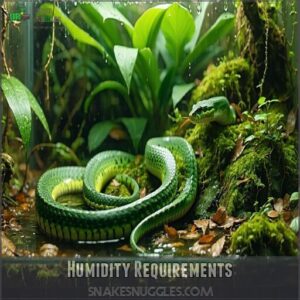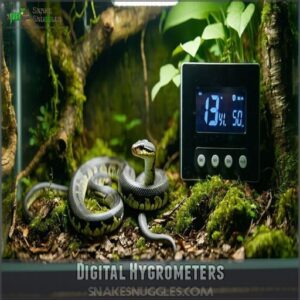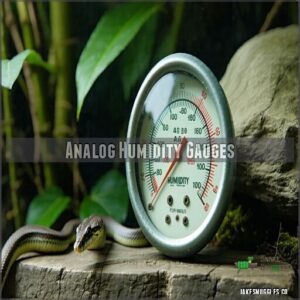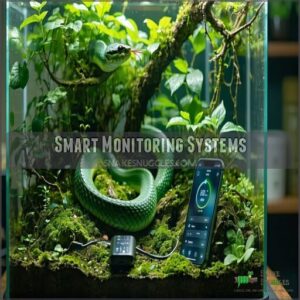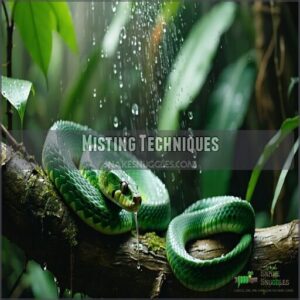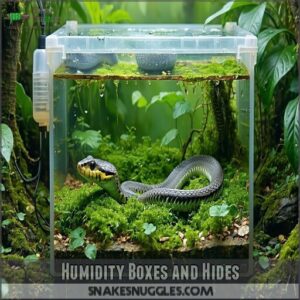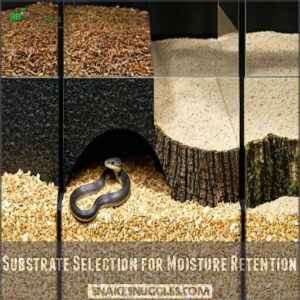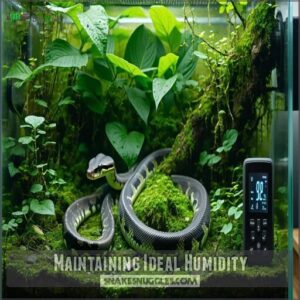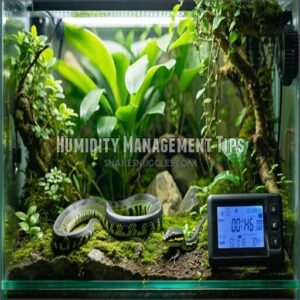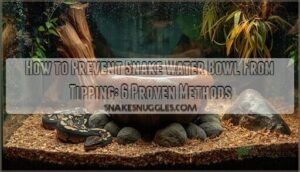This site is supported by our readers. We may earn a commission, at no cost to you, if you purchase through links.
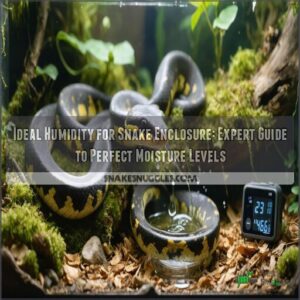
Tropical snakes, like ball pythons, do best with 70-80% humidity, while desert species, such as corn snakes, prefer a drier 20-40%.
Temperate snakes, like king snakes, tend to thrive around 50-60%.
To maintain these levels, use a digital hygrometer for accuracy, and adjust with misting, water bowls, or better ventilation.
Remember, too much or too little moisture can cause health issues, like respiratory infections or shedding problems.
Understanding your snake’s needs is key—and don’t worry, managing humidity isn’t as tricky as it sounds once you’ve got the basics down, and with practice, you’ll find it’s all about creating the right environment.
Table Of Contents
- Key Takeaways
- Humidity Requirements
- Measuring Humidity Levels
- Humidity Control Methods
- Maintaining Ideal Humidity
- Humidity Management Tips
- Frequently Asked Questions (FAQs)
- Is 80% humidity too high for ball pythons?
- What happens if a snake enclosure is too humid?
- Is 70 humidity too high for a corn snake?
- Do snakes need humidity?
- How do you keep a snake humid?
- Do snake enclosures need a humidifier?
- How do I create a perfect humidity level in my snake’s habitat?
- How humid should a snake tank be?
- Is 70 humidity too high for ball python?
- Is 50% humidity okay for a ball python?
- Conclusion
Key Takeaways
- Use a reliable digital hygrometer to monitor humidity accurately and place it away from water and heat sources for consistent readings.
- Adjust humidity levels based on your snake’s species: tropical snakes need 70-90%, desert snakes need 20-40%, and temperate snakes need 50-70%.
- Mist daily or as needed, use moisture-retaining substrates like coconut fiber, and place water bowls strategically to maintain ideal humidity.
- Keep an eye on shedding cycles and seasonal changes; increase humidity during shedding and adjust for climate variations to ensure your snake’s health and well-being.
Humidity Requirements
You’ll need to maintain specific humidity levels in your snake’s enclosure based on its native habitat, with tropical species requiring 70-90%, desert species needing 20-40%, and temperate species thriving at 50-70%.
Proper humidity control prevents health issues like respiratory infections, dehydration, and shedding problems that can affect your snake’s overall well-being.
Species-Specific Needs
Different snake species require specific humidity levels based on their native habitats.
Your enclosure’s moisture level directly impacts your snake’s health and behavior.
- Tropical snakes (like Ball Pythons): Need 70-90% humidity
- Desert snakes (such as Rosy Boas): Thrive in 20-40% humidity
- Temperate snakes (including Corn Snakes): Require 50-70% humidity
- Boa Constrictors: Need 55-75% humidity
Matching reptile humidity to natural environments prevents respiratory issues and guarantees proper shedding.
Tropical Snake Humidity
Tropical snakes need higher humidity levels than other species, typically 70-90%. These reptiles naturally live in moisture-rich environments where water vapor helps with proper hydration and shedding.
Tropical snakes thrive in moisture-rich environments, relying on 70-90% humidity for hydration, smooth shedding, and vibrant health.
For successful microclimate creation, use moisture-retaining substrates like coconut fiber or cypress mulch. Daily misting and large water dishes boost enclosure humidity naturally.
Remember, proper snake humidity prevents respiratory infections while ensuring smooth, complete sheds. Hygrometers are your best friends for monitoring these levels accurately.
It’s also important to prevent common humidity mistakes and understand that smooth, complete sheds are a result of well-maintained humidity levels, which is crucial for the health of tropical snakes.
Desert Snake Humidity
Unlike their tropical cousins, desert snakes thrive in much drier conditions.
You’ll want to maintain humidity levels between 20-40% for arid snake species like Rosy Boas and Sand Boas.
Too much moisture can actually cause respiratory issues in these reptiles, so it’s crucial to control the environment carefully, watching for signs of dehydration when controlling enclosure humidity.
Use ReptiSand as a substrate option to retain heat rather than moisture, especially during shedding when they may need slightly higher humidity levels.
Temperate Snake Humidity
For temperate snakes like corn snakes and king snakes, humidity levels should stay between 50-70%.
This middle-of-the-road range mimics their natural habitat and supports healthy shedding.
During shedding, bump up enclosure humidity to 65-75% to help your snake slip out of its old skin easily.
Monitor humidity levels daily with a reliable hygrometer, as seasonal variations can impact your temperate species’ health and comfort.
Measuring Humidity Levels
You’ll need an accurate hygrometer to monitor the moisture levels in your snake’s home, which helps prevent health issues caused by incorrect humidity.
Proper placement of your measuring device, away from water dishes and heat sources, guarantees you get reliable readings that represent the actual conditions your snake experiences, ensuring accurate monitoring of its environment.
Digital Hygrometers
Now that you understand what humidity your snake needs, you’ll need a reliable way to measure it.
Digital hygrometers offer the most precise humidity measurement with several advantages:
- Greater accuracy (±3% compared to ±5-10% for analog models)
- Easy-to-read displays that show exact numbers instead of ranges
- Additional features like data logging to track humidity patterns over time
Place your digital thermometer-hygrometer centrally in the enclosure for ideal humidity monitoring. Many reptile owners find specialized snake products particularly useful.
Most units need calibration before first use.
Analog Humidity Gauges
While digital hygrometers offer precision, analog humidity gauges remain a budget-friendly option for snake owners.
These classic dial-style meters show humidity levels with a needle display. Be aware of analog accuracy challenges—they’re often off by 10-15%.
Proper placement is essential; keep them away from water dishes and heat sources. Regular calibration methods help maintain readings in your snake’s ideal humidity range.
Many retailers offer various analog models for purchase. Despite reading challenges, with proper maintenance needs, they’ll serve as reliable backup monitors.
Smart Monitoring Systems
While analog gauges work well, smart monitoring systems take your snake’s humidity management to the next level.
These tech-savvy tools connect to your phone, giving you peace of mind wherever you are.
Three key benefits of smart humidity monitoring:
- Remote monitoring lets you check levels from anywhere
- System alerts notify you when humidity falls outside safe ranges
- Data logging tracks patterns to help optimize your snake’s environment
Humidity Control Methods
You’ll need several effective tools and methods to maintain proper humidity levels in your snake’s habitat, including water dishes, appropriate substrates, misting systems, and possibly humidifiers.
Managing these elements correctly guarantees your snake can shed properly and stay healthy, preventing common issues like respiratory problems and difficult shedding cycles, which is crucial for maintaining a healthy environment, and humidifiers can be a key tool in this process.
Misting Techniques
Many snake owners find regular misting essential for maintaining proper humidity.
You’ll want to mist your enclosure once or twice daily using dechlorinated water.
Keep your misting duration brief—just enough to create moisture without soaking the substrate.
For equipment types, choose between manual spray bottles or automatic sprayers.
Direct misting of your snake helps with hydration, while spraying enclosure surfaces guarantees consistent moisture levels throughout.
Humidity Boxes and Hides
Humidity boxes and hides offer your snake a retreat where moisture levels remain higher than the main enclosure.
You’ll need a small container with an entrance hole, filled with damp sphagnum moss, to create a humidity gradient.
Place these DIY humidity boxes in the enclosure’s cooler section, and clean them weekly to prevent mold.
For shedding snakes, a humid hide provides essential moisture for easier skin removal, and reptile owners can purchase a snake hide to help maintain proper humidity.
Substrate Selection for Moisture Retention
Through careful selection of substrate, you can maintain ideal humidity levels in your snake’s enclosure.
Substrates like coconut fiber and cypress mulch excel at moisture retention, while ReptiSand works better for desert species needing drier conditions.
ReptiBark absorbs moisture effectively for tropical snakes, creating a natural environment that helps prevent mold.
Each substrate type offers different moisture capacity, so choose based on your specific snake’s humidity requirements.
For example, you can use coco coir substrates to retain water well while providing good drainage.
Maintaining Ideal Humidity
You’ll need to adjust your enclosure’s ventilation, heat sources, and water features regularly to maintain the perfect humidity level for your snake’s health.
Consistent monitoring with a reliable hygrometer will help you make timely corrections before moisture levels become too high or too low for your particular snake species, ensuring consistent monitoring is key.
Improving Ventilation
When humidity gets too high in your snake enclosure, proper ventilation becomes your best friend.
Balance airflow by adding small vents near the top of the tank to release excess moisture. Screened enclosures naturally provide more airflow, while glass tanks retain humidity better.
For large enclosures, a small fan on low setting can improve natural ventilation without drastically dropping moisture levels. Remember, good snake care means finding that perfect humidity balance through controlled airflow.
Adjusting Heat Sources
Your heat sources play a key role in maintaining proper humidity levels.
When ventilation isn’t enough, you can adjust your heating setup to better control moisture.
Heat source placement directly impacts your enclosure’s humidity:
- Under-tank heaters create less air movement, preserving moisture better than overhead options
- Heat lamps increase evaporation and lower humidity through infrared radiation
- Ceramic heat emitters maintain temperature without substantially drying the air
Always use a reliable thermostat with any heat source to prevent dangerous temperature spikes.
Maintaining the ideal temperature gradient is also essential for the snake’s health.
Reducing Water Sources
When your snake enclosure’s humidity levels are too high, reducing water sources is a simple fix.
Switch to smaller dishes in cooler areas to limit evaporation. Use dry substrates like paper or ReptiSand instead of moisture-retaining materials.
Add more absorbent decor to soak up excess moisture, and boost ventilation with additional air holes.
Strategic placement of all humidity sources away from heat will help maintain ideal snake humidity control, which is crucial for reducing water sources effectively.
Humidity Management Tips
You’ll need to adjust your snake’s humidity levels with the changing seasons, just as their wild counterparts experience different moisture conditions throughout the year.
Using digital hygrometers, proper substrate selection, and consistent monitoring will help you maintain the precise moisture balance your specific species needs.
Whether it’s a tropical ball python requiring higher humidity or a desert rosy boa needing drier conditions, these adjustments are crucial for their well-being.
Seasonal Adjustments
Adapting to seasonal changes requires thoughtful humidity adjustments for your snake’s enclosure.
During winter, indoor heating often decreases humidity levels, so you’ll need more frequent misting and larger water dishes.
Summer ventilation becomes essential as ambient humidity naturally rises.
Monitor shedding seasons closely, as snakes need higher humidity when shedding. Regional climates affect humidity fluctuations differently, so adjust accordingly.
Remember that breeding season may require specific humidity adjustments for successful reproduction. A hygrometer helps to monitor humidity levels effectively.
Balancing Humidity and Temperature
Understanding how temperature changes impact snake humidity is key.
Warmer spots boost evaporation rates, raising humidity, while cooler areas risk condensation and health issues.
Use thermostat integration to stabilize temperature, ensuring species thermoregulation.
Balance humidity levels through consistent humidity management.
Precision in humidity regulation avoids risks like dehydration or respiratory concerns, creating a safe, comfortable zone for your snake.
Automated Humidity Control Systems
Automated humidity control simplifies snake enclosure care by maintaining ideal levels.
Use systems with scheduled misting, remote monitoring, and failure alerts for reliability.
System calibration guarantees accurate operation, while backup systems prevent disruptions.
An automatic sprayer or misting system keeps humidity steady.
These tools mimic natural cycles, reducing stress and keeping your reptiles healthy without constant manual adjustments, which is crucial for reliable and healthy environments.
Frequently Asked Questions (FAQs)
Is 80% humidity too high for ball pythons?
Imagine wearing a raincoat indoors—that’s how your ball python might feel at 80% humidity.
It’s too high for their comfort, causing respiratory issues.
Stick to 40-55%, with 60-70% during shedding.
What happens if a snake enclosure is too humid?
When your snake’s enclosure is too humid, it can encourage bacterial and fungal growth, leading to skin infections and respiratory problems.
Excessive moisture also harms their shedding process, potentially causing stuck skin or scale issues, which can be related to respiratory problems.
Is 70 humidity too high for a corn snake?
Think of humidity like a thermostat for health.
For a corn snake, 70% is slightly high. Aim for 60%.
Excess moisture can cause respiratory issues, so adjust with better ventilation or smaller water bowls.
Do snakes need humidity?
Yes, snakes need proper humidity to stay healthy.
It helps with hydration, shedding, and respiratory health.
Without it, they can face dehydration, infections, or trouble shedding.
Tailoring humidity to their species guarantees they thrive and is essential for their overall health.
How do you keep a snake humid?
Keeping your snake’s enclosure humid is like balancing nature indoors.
Use a hygroscopic substrate, mist daily, and add a water dish.
For tropical snakes, combine misting with a humidifier.
Monitor levels using a hygrometer.
Do snake enclosures need a humidifier?
You don’t always need a humidifier, but it can help maintain consistent humidity, especially for tropical snakes.
Combine it with misting, water bowls, and substrates to balance moisture and avoid respiratory issues.
How do I create a perfect humidity level in my snake’s habitat?
To create the perfect humidity level, use a hygrometer to monitor moisture.
Mist the enclosure as needed, place water bowls near heat sources for evaporation.
Choose a substrate like cypress mulch to retain moisture.
How humid should a snake tank be?
Most snakes need humidity between 50%-70%, but it varies by species.
Tropical snakes like green tree pythons thrive at 70%-90%, while desert snakes like rosy boas prefer 20%-40%.
Use a hygrometer to monitor accurately.
Is 70 humidity too high for ball python?
Ball pythons thrive with 40-55% humidity, but 60-70% is ideal during shedding.
At 70%, keep an eye out for mold or respiratory issues.
Proper ventilation and a hygrometer help maintain a healthy environment.
Is 50% humidity okay for a ball python?
Fifty percent humidity is okay for a ball python in its resting phase.
However, during shedding, increase it to 60-70% to help with skin separation.
Keeping humidity balanced avoids dehydration and shedding problems, which can be critical to prevent, especially considering shedding problems.
Conclusion
Creating the ideal humidity for a snake enclosure isn’t some mystical art of rain-dancing; it’s about understanding your snake’s habitat.
Start with a reliable hygrometer, adjust humidity using tools like misting or ventilation, and monitor for changes.
Whether it’s tropical, desert, or temperate needs, balance moisture carefully to prevent health issues.
Knowledge and consistency make it manageable, allowing you to create a perfect home where your snake thrives—happy, healthy, and free from stress or shedding woes, with practice and careful attention to humidity.
- https://www.customcages.com/?s=humidity&submit=
- https://www.thebiodude.com/blogs/how-do-i-create-a-bioactive-vivarium/how-to-place-thermometer-and-hygrometer-probes
- https://www.reptifiles.com/wp-content/uploads/2020/01/Why-Infrared-Matters-by-Roman-Muryn.pdf
- https://www.aquariumsystems.eu/gold-infrared-lamp-unit-uk-c2x38678216
- https://www.foliage-factory.com/post/the-ultimate-guide-to-houseplant-substrates?srsltid=AfmBOooWi3ysrmDFtORZvjNrIUOCaAwiXJ7TuoR4NlTIlH0oJxjjiHfk

